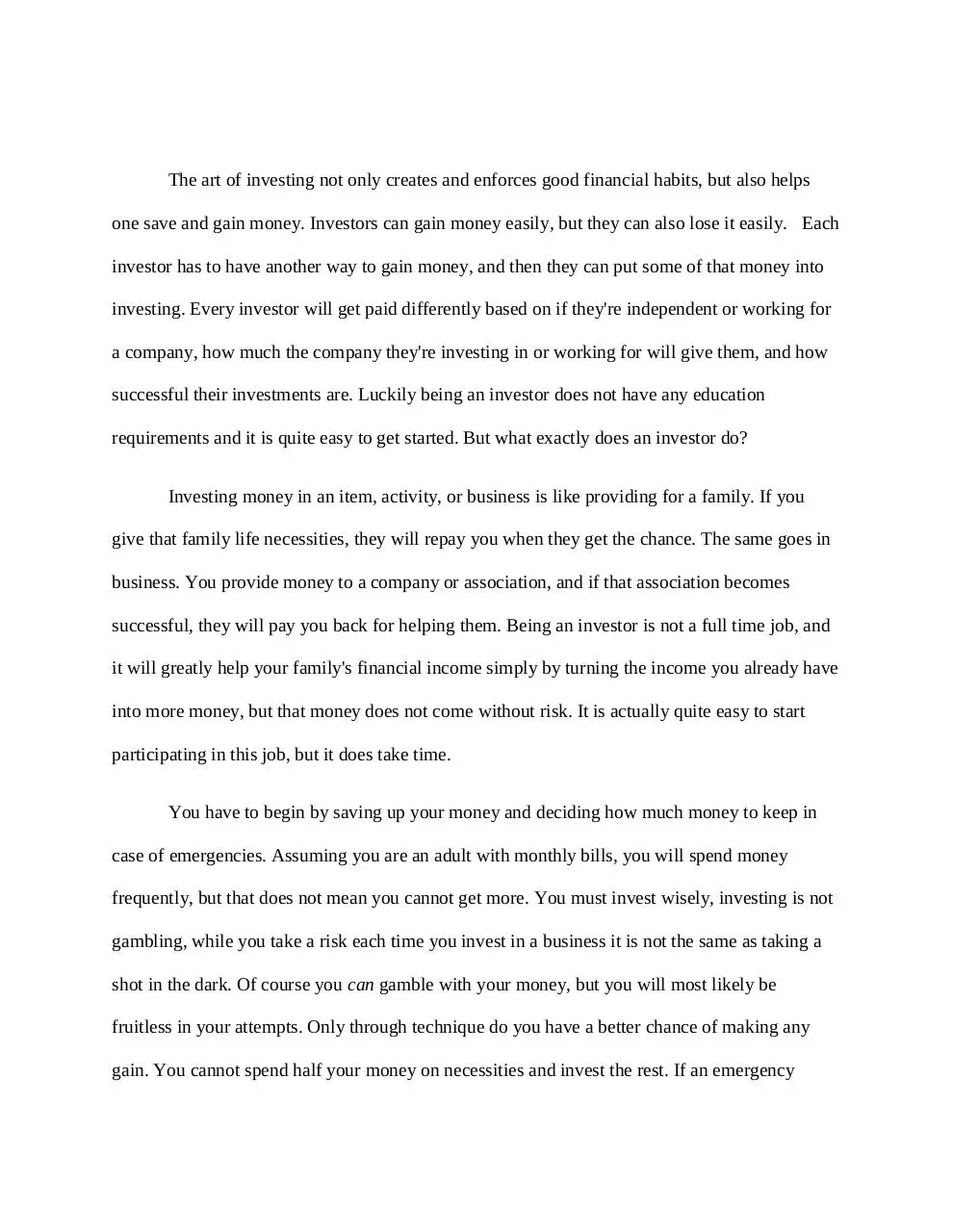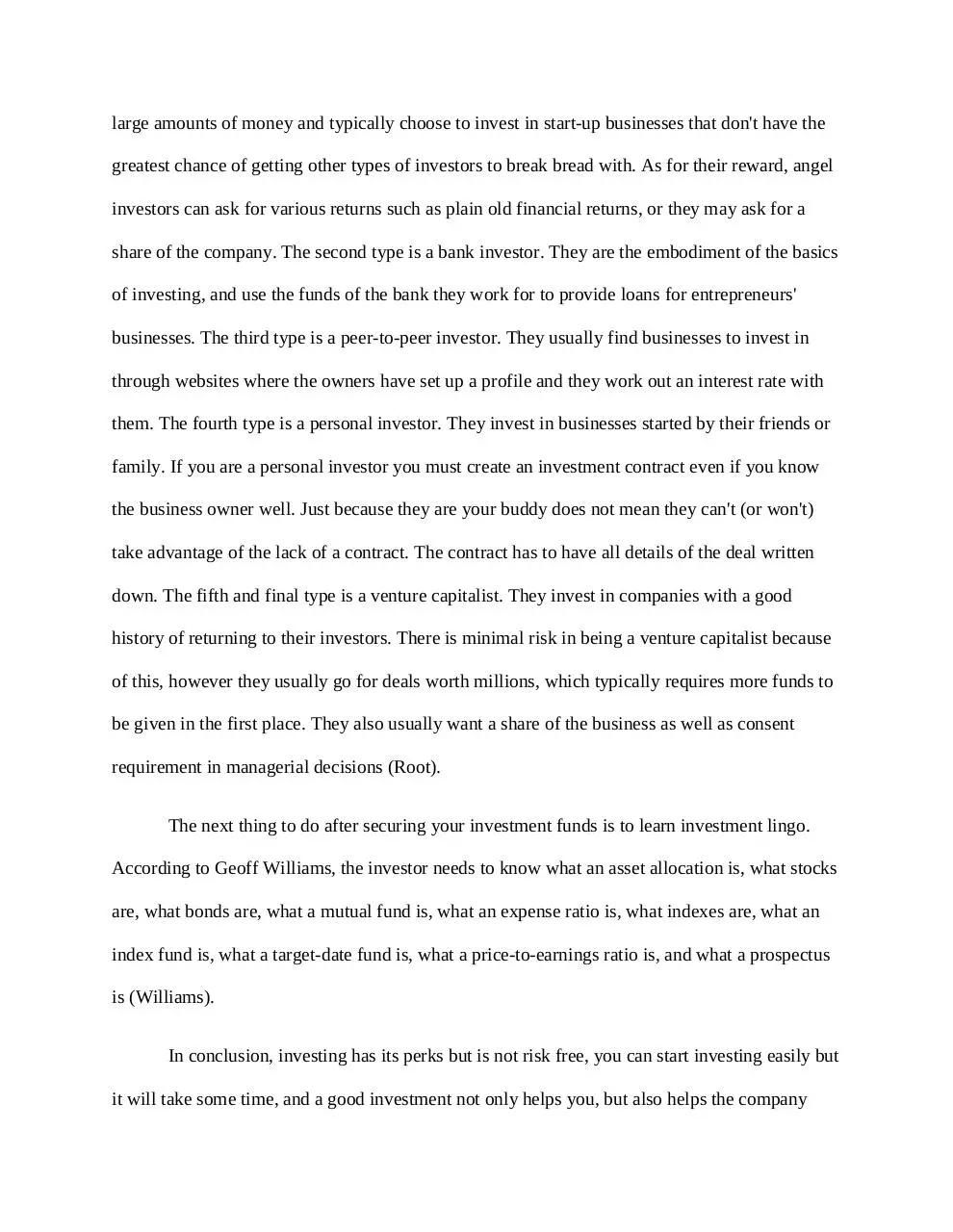InvestingEdited (PDF)
File information
This PDF 1.3 document has been generated by http://www.convertapi.com, and has been sent on pdf-archive.com on 26/05/2016 at 07:26, from IP address 70.190.x.x.
The current document download page has been viewed 290 times.
File size: 93.4 KB (4 pages).
Privacy: public file




File preview
The art of investing not only creates and enforces good financial habits, but also helps
one save and gain money. Investors can gain money easily, but they can also lose it easily. Each
investor has to have another way to gain money, and then they can put some of that money into
investing. Every investor will get paid differently based on if they're independent or working for
a company, how much the company they're investing in or working for will give them, and how
successful their investments are. Luckily being an investor does not have any education
requirements and it is quite easy to get started. But what exactly does an investor do?
Investing money in an item, activity, or business is like providing for a family. If you
give that family life necessities, they will repay you when they get the chance. The same goes in
business. You provide money to a company or association, and if that association becomes
successful, they will pay you back for helping them. Being an investor is not a full time job, and
it will greatly help your family's financial income simply by turning the income you already have
into more money, but that money does not come without risk. It is actually quite easy to start
participating in this job, but it does take time.
You have to begin by saving up your money and deciding how much money to keep in
case of emergencies. Assuming you are an adult with monthly bills, you will spend money
frequently, but that does not mean you cannot get more. You must invest wisely, investing is not
gambling, while you take a risk each time you invest in a business it is not the same as taking a
shot in the dark. Of course you can gamble with your money, but you will most likely be
fruitless in your attempts. Only through technique do you have a better chance of making any
gain. You cannot spend half your money on necessities and invest the rest. If an emergency
happens after you invest you will have no money left to pay for the damages, and if that
investment fails you will have completely lost all of your money. You must save your money,
and eventually you can invest it. Investing is not something you decide to do just because you
feel like it, it takes months of preparation just to get started, so the sooner you start the better.
According to pages 24-26 of Investing Demystified by Paul J. Lim you must figure out exactly
how to save the proper amount of money by following these three easy steps.
Step 1: Add up your monthly income, not only from any paychecks but from any other
income source, even if it is not an official one.
Step 2: For three months count and add the cost of literally everything you pay for, even
small things like a water bottle or a lollipop, and big things like rent, insurance, and taxes.
Double your total for your health and life insurance in your records. If you are a member of a
family or have children, add at least twelve more of your current total. At the end of the three
months divide your total by three and you will have your average monthly bill.
Step 3: Subtract your answer from step 2 out of your answer from step 1. Multiply this
total by 6 and this should be the amount of money you save up and set aside for emergencies.
Make sure you have more than this much extra money before you start investing, and that you
have at least this much extra money at all times. Never invest this money (Lim).
Once you have your funds in order, you have to find out what kind of investor you want
to be. There are many different types of investors and many different things to invest in. Often
times people are a mix of these investor types because usually one type won't completely reach
the goals you have.
According to George N. Root III, the first type is an angel investor. They have access to
large amounts of money and typically choose to invest in start-up businesses that don't have the
greatest chance of getting other types of investors to break bread with. As for their reward, angel
investors can ask for various returns such as plain old financial returns, or they may ask for a
share of the company. The second type is a bank investor. They are the embodiment of the basics
of investing, and use the funds of the bank they work for to provide loans for entrepreneurs'
businesses. The third type is a peer-to-peer investor. They usually find businesses to invest in
through websites where the owners have set up a profile and they work out an interest rate with
them. The fourth type is a personal investor. They invest in businesses started by their friends or
family. If you are a personal investor you must create an investment contract even if you know
the business owner well. Just because they are your buddy does not mean they can't (or won't)
take advantage of the lack of a contract. The contract has to have all details of the deal written
down. The fifth and final type is a venture capitalist. They invest in companies with a good
history of returning to their investors. There is minimal risk in being a venture capitalist because
of this, however they usually go for deals worth millions, which typically requires more funds to
be given in the first place. They also usually want a share of the business as well as consent
requirement in managerial decisions (Root).
The next thing to do after securing your investment funds is to learn investment lingo.
According to Geoff Williams, the investor needs to know what an asset allocation is, what stocks
are, what bonds are, what a mutual fund is, what an expense ratio is, what indexes are, what an
index fund is, what a target-date fund is, what a price-to-earnings ratio is, and what a prospectus
is (Williams).
In conclusion, investing has its perks but is not risk free, you can start investing easily but
it will take some time, and a good investment not only helps you, but also helps the company
you've invested in.
Download InvestingEdited
InvestingEdited.pdf (PDF, 93.4 KB)
Download PDF
Share this file on social networks
Link to this page
Permanent link
Use the permanent link to the download page to share your document on Facebook, Twitter, LinkedIn, or directly with a contact by e-Mail, Messenger, Whatsapp, Line..
Short link
Use the short link to share your document on Twitter or by text message (SMS)
HTML Code
Copy the following HTML code to share your document on a Website or Blog
QR Code to this page

This file has been shared publicly by a user of PDF Archive.
Document ID: 0000376807.